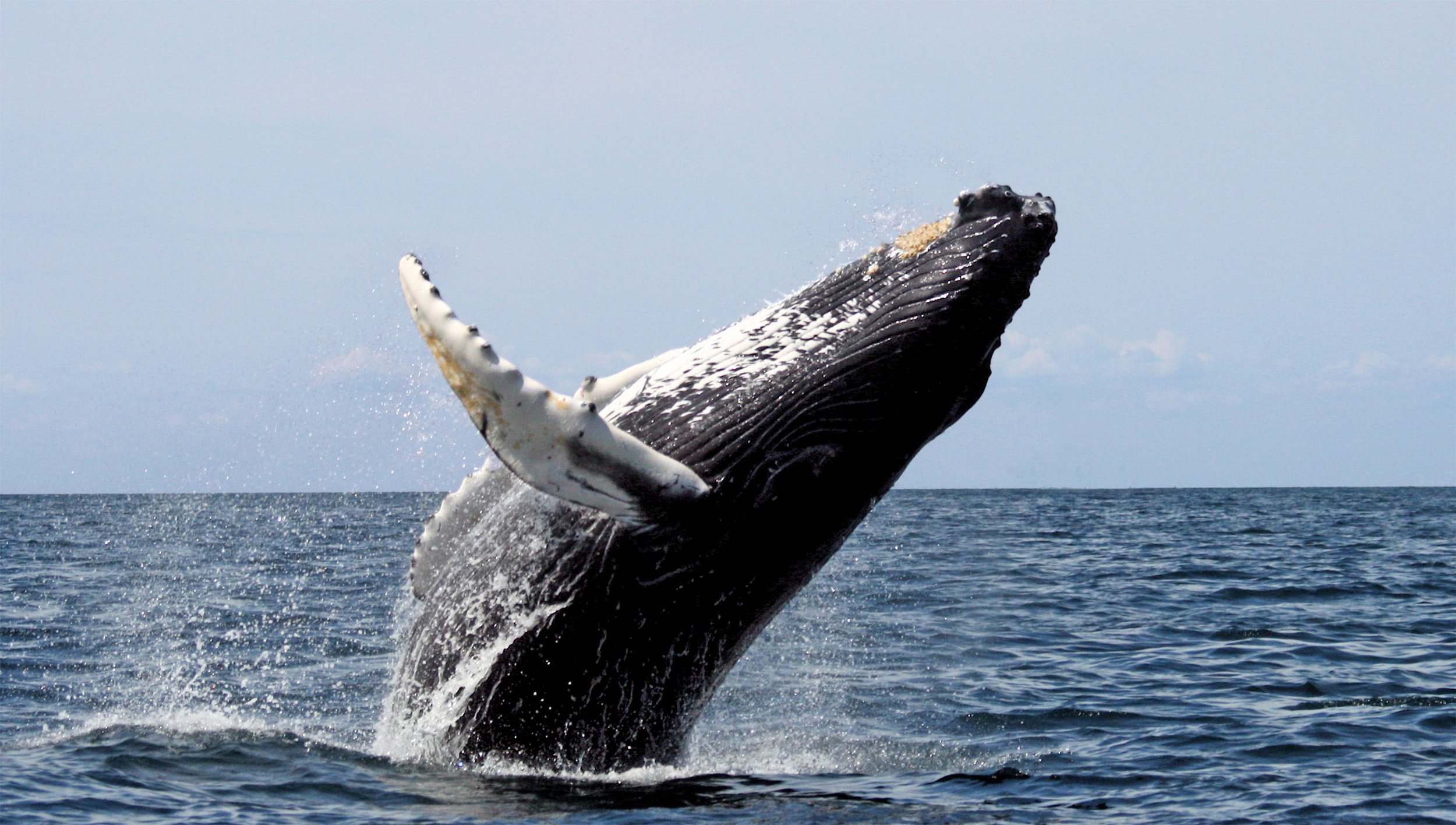Ship Noises Mute the Songs of Humpback Whales
Drowned out by the din of passing ships, humpback whales attempting to breed off the coast of Japan are cutting their conversations short.

A humpback whale breaching near Stellwagen Bank National Marine Sanctuary in Massachusetts Bay. These whales may be imperiled by the sounds of passing ships, which silence their songs during mating season. Photo Credit: Whit Welles, Wikimedia Commons
With its enigmatic chorus of clicks, groans, and whistles, the haunting opus of the humpback whale (Megaptera novaeangliae) is one of the ocean’s most striking sounds. Every winter, humpbacks may swim thousands of miles to their seasonal breeding grounds, where males competing for mates fill the waters with soft serenades. But off the coasts of Japan, these seas are falling silent—and it seems humans are to blame.
Today, in the journal PLOS ONE, researchers report that the noises emanating from human-operated cargo ships disrupt the mating songs of humpback whales. Drowned out by the underwater din, some whales are even going completely mum in the vicinity of these vessels—which could have serious consequences for their reproductive success.
Beneath the surface of the sea, light falters fast. But because sound travels faster in water than air, keen audiophiles like the humpback whale use sound to navigate the dimly lit underwater world. These gentle giants engage in casual chatter year-round, but breeding season tends to feature prominent displays of song from males. Whale compositions are exquisitely complex, with at least 34 distinct sound types in the repertoire. Males will carefully remix their melodies as the years go by, and even pass tunes from population to population like vocal culture.
Despite all this, scientists still aren’t entirely sure why male humpbacks sing. Though musicality surges during periods of mating, song could serve a multitude of purposes, from gruff territorial warnings to come-hither calls. Whatever the whales’ rationale, it’s clear that song is crucial: Once they’ve warmed up, humpbacks can sing for hours on end, their ghostly echoes reverberating up to 100 miles through the surrounding sea.
But when humans enter the mix, being pitch perfect can be a double-edged sword. Unnatural noises from technological advancements like seismic airguns and military sonar have permanently disabled—and even killed—whales and their seafaring relatives.
Even the low-frequency hum of ships appears to perturb whales in conversation. The drones emitted by these ships can actually overlap with the frequencies of whale song, making it more difficult for humpbacks to pick out important bits of intel from the surrounding cacophony—the underwater equivalent of struggling to hear a friend in a busy restaurant.
Several researchers have observed whales changing their behavior in the presence of ships. However, compared to unmistakable consequences from airguns and sonar, it’s been challenging to reach a consensus on the extent of the effects of these more muted sources of noise, explains study author Tomonari Akamatsu, a biologist at the Japan Fisheries Research and Education Agency. In shipping hubs that see a lot of traffic, for instance, it’s difficult to disentangle which among the many possible disturbances are most problematic.
But the small outpost of Chichijima in Japan’s Ogasawara Islands presented a rare opportunity for Akamatsu and his colleagues. Separated from the southeastern coast of Japan by over 600 miles, the 2,000 or so residents of Chichijima receive just one daily ship: the Hahajima Maru, a small passenger-cargo vessel that ferries in a regular supply of goods and people from afar.
For the most part, the waters in this remote part of the world are quiet. But each winter, the seas swell with the symphony of hundreds of humpback whales eager to mingle with their mates—giving the researchers the chance to observe the effects of a single ship on the behavior of a wild population. The pristine nature of this locale stripped away other variables that could muddy the waters—other vessels, for instance, or inconsistent traffic.
“This study presents a really special and unique situation,” says Rosalind Rolland, a whale expert and veterinarian at the Anderson Cabot Center for Ocean Life at the New England Aquarium who did not participate in the research. “It’s very difficult to find anywhere in the ocean where there is just a single source of ocean noise. Most times there is noise from all directions.”
By placing two recorders in the waters near Chichijima, the researchers captured a series of whale vocalizations between the months of February and May 2017. Each day, they recorded one or two male humpbacks, amassing tracks of 53 soloists in total—half in the presence of the ship, and half without. The team also used the recordings to pinpoint the whales’ positions relative to the machinery as they sang, tracking their movements through time.
When the team mapped out the whales’ responses, the results were sobering. If the vessel was present, it produced, at its loudest, about 150 decibels of noise, comparable to the volume of a shotgun—and humpbacks seemed to shirk from its path, vacating the areas closest to the shipping lane. The whales that remained within 1200 meters of the ship produced fewer sounds overall. Some even cut their serenades off entirely—and most who did still hadn’t resumed their songs half an hour after the ship had passed through.

Humpback whales rely on sound to communicate in the dark ocean waters. During their winter breeding season, males will sing for hours on end—but their serenades may be stifled by the sounds of passing ships. Photo Credit: Christopher Michel, flickr
Akamatsu had initially assumed that in the presence of the ship, the humpbacks would raise their voices or change the frequency at which they sang—both strategies that might enable whales to discern calls above the clang and clamor. But, he says, perhaps this reticent response is an adaptive, energy-saving strategy.
“It’s actually very clever,” Akamatsu explains. “They know it’s temporary, so they just wait for it to pass.”
Vocal adjustments, after all, are exhausting. Even 500 to 1200 meters away from the ship, the whales were still contending with a noise level of about 100 decibels—roughly equivalent to a motorcycle or a raucous rock band. Perhaps, instead of attempting to outperform the uproar, humpbacks were simply waiting out the storm.
Every whale who stopped his song did eventually rebound from the chorus interruptus—and such resilience may spell tentatively good news for the residents of Chichijima, who remain tied to the Hahajima Maru’s regular visits. “This ship is a lifeline for an isolated island,” Akamatsu explains. “Humans need that ship to survive.”
But Michelle Fournet, a wildlife scientist in the Bioacoustics Research Program at Cornell University, points out that it’s also possible the humpbacks’ silence may not be indicative of flexibility at all. Muted by the regularity of passing ships, whales may be running out of sustainable strategies to cope, and instead accepting defeat. While bellowing above the fray may be exhausting, it at least offers whales a fighting chance of still being heard. Complete silence, on the other hand, brings the probability of communication down to zero. If humpbacks want any shot at coupling up, they can only wait so long for ambient noise to die down.
“Humpbacks have to contend with a lot of variability,” says Fournet, who was not involved in the research. “And they’re capable of adapting to natural sounds. But they may not always be able to apply those same strategies to [human-made] noise.”
While no long-term repercussions have yet been found, it will be imperative to measure the ship’s effects on humpback reproduction, Fournet adds. Even though most populations of humpbacks are no longer considered endangered, pods around the world remain vulnerable to human interference. And despite decades of study, researchers are still puzzling through the intricacies of whale song. It’s unclear how disastrous even the tiniest tweaks to a tune could be for humpbacks trying to find each other in the dark.
And, of course, the calm of Chichijima is the exception, not the rule: Most ships don’t sail solo. Acoustic pollution from human-made vessels will likely be on the upswing for years to come, warns Paul Wensveen, a biologist who studies marine acoustics at the University of Iceland. Even technological Band-Aids like insulators, which muffle the sound from ships’ propellers, are quickly overwhelmed by the sheer volume of noise radiating from the world’s busiest ports.
If humankind’s presence in the ocean continues to grow, there may soon be little stopping the whales’ brief intermission in song from turning into an irreversible coda.
“Some of the whales’ strategies have been successful so far,” says Fournet. “But as the ocean gets louder, and more vessels come in, we can only expect to see more changes.”

